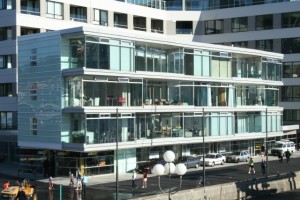The NZIA Wellington branch outperformed themselves last night, at the Awards ceremony held at the City Gallery. A large swathe of awards were given out, the full list of which is available at the NZIA’s website complete with pictures, and also a list available on the DominionPost website. For your convenience, we’ve put a selection of the awards up here (and also so that our foreign roving correspondent m-d can see them at his leisure).

Big thanks to Resene of course, who always know how to throw a good party, to John Mills for his Chairmanship, to Brendon Pongia for his crisp Mastery of the Ceremonies, and of course also to the Judges / Jury who toured the country side looking at 2009’s architecture: Angela Foster, Michael Melville, Morten Gjerde, and Cathryn Munro. Other shout outs go to Mani Dunlop for her powerful lungs last night, and a welcome to Paul Kerr Hislop who confesses that he goes to visit the Eye of the Fish every day, but has never been to the Architectural Centre website! Shame on you – but welcome, if you ever get to read this. And congratulations on your award.
So: who got an award then?

Big news of the night obviously has to go to the BNZ new headquarters down on the waterfront, which won not one, not two, but Three awards last night: Commercial architecture, Interior architecture, and Sustainability. Well done to all at Jasmax, especially Warren Young and Tim Hooson. And that goes for Fletcher Construction as well – very smooth construction project. The Judges said:
Commercial Citation : With a strong articulated façade this building stands out as an exemplary detailing project. Viewed from both the water and the city it is a strong sculptural element within the cityscape.
Interiors Citation : Rigorous spatial planning has resulted in the creation of interior rooms. A subtle change in materials and furniture placement divides the open plan floor plates into distinct areas while also directing the focus towards the harbour view.
Sustainability Citation : With multi-disciplinary contributions from the fields of art and science, the resulting environment is not only spatially dynamic, but also an invigorating place to “live within”. Ecological and social considerations have been well considered. Ms Foster said: “This is a totally different way of looking at an office building, the epitome of open plan and rather like a mini city.”

A large number of architects who are members of the Architectural Centre were winners last night, with, in typical Wellington manner, a great number of exceedingly fine residential winners in the Housing category. Wellington always has done individual houses very well, although sometimes the larger buildings seem to have struggled a bit. One of the larger buildings that obviously has survived the years very well is the Westpac building by Stephenson and Turner – still looking fine and well-deserving of its Enduring Architecture award.

Jurors said the elegantly restrained facade and interior of the Westpac building had stood the test of time, transcending styles and fashions.
As was the Roger Walker designed Ainsworth house at Korokoro which was allegedly responsible for siring 5 children and 14 grandchildren by its enthusiastic owner.

The Ainsworth House was a seen as “Very much a celebration of archetypal 1970’s Wellington architecture. “It is what you think of when someone says ‘Roger Walker,’ “ said Ms Foster. “It’s like an adult’s playhouse, with lots of quirky spaces and little nooks and crannies”.
An award for Sustainability also goes to Studio Pacific for their work on Aorangi House, which Prime Property have redeveloped for Beca, and if I may say so, looks rather smart now.
“Intelligent sustainable interventions applied to an existing multi-storey building.”

Jury convenor, architect Angela Foster, said the standard of entries had been very high and it was encouraging to see that sustainable principles were now integrated into the design process and evident across both commercial and residential projects. “It is now something that is integral to projects rather than just added on and it is clear that it is something clients are asking for,”
Other winners:
Wellington Regional Hospital by CCM Architects in association with Rice Daubney (early stages only)

Hailed by Ms Foster as an innovative hospital design. Jurors also said the project, based on the ‘model of care’ concept had worked extremely well making the building accessible despite its massive scale.
Chews Lane Precinct by Athfield Architects

Chews Lane, a winner in urban design, was praised as having revitalised the site, achieving intimacy and diversity at pedestrian level, again despite being a project on a huge scale.
Moore Wilson Fresh by Athfield Architects

Moore Wilson Fresh was described as a “subtly detailed urban market” with jurors noting that the client/architect association of 40 years’ standing had resulted in a “dynamic relationship between shopper, product and space”.
Te Puni Village – Victoria University of Wellington student residences, by Architectus

Seen as a “celebration of light and colour within the urban landscape”. Ms Foster said: “This could simply have been any multi storey building but instead is a refined gesture to the city. At night it is a sparkling lantern on the city ridgeline.”
Herd Street Development in Wellington, by Archaus Architects and Warren + Mahoney Architects in Association,

The sole winner in residential architecture – multiple housing. Jurors were captivated by the boathouse, described as “jewel of the harbour”.
Wellington Waterfront Framework by WCC Architects

Wellington Waterfront Framework, which guides the future development of Wellington’s central waterfront area, was a winner in urban design winning acclaim as “an example of “where urban design is about process rather than product”.
Villa Melina Boutique Homestay in Seatoun, by Novak + Middleton Architects

A winner in commercial architecture, “exuded comfort” while incorporating cutting edge sustainable approaches and many European ideas and products suggested by the Swiss clients.
Central Forklifts Building at Avalon, by Designgroup Stapleton Elliott,

Won accolades as an elegant response to an industrial subject.
Railway Social Hall behind Wellington Railway Station, by CCM Architects,

The social hall won accolade for an elegant refurbishment which is contemporary yet sympathetic to the structure, allowing the hall to “regain its grandeur”.
Days Bay Changing Rooms by John Mills Architects.

The changing rooms have also been revitalised with a contemporary sculptural interior moving the focus towards the public beach while respecting the shell of the original building.
Victoria University Coastal Ecology Laboratory by Pynenburg & Collins Architects,

A winner in public architecture with jurors remarking on the well resolved laboratory spaces feeding off a central core.
Osteria Del Toro Restaurant, by Designgroup Stapleton Elliott,

Interior design award, with the décor summed up as creating “a rich and unique dining experience”. “Unashamedly lavish.”
Wellington residential
Harding house, by Athfield Architects

Hilltop home in Melrose, provides shelter from the Wellington winds while encasing a warm and tranquil interior. Jurors hailed the property as simple, refined and “an outstanding example of site responsive architecture”. Praised as an “elegant bunker,”
Collins Wiles House at Ngaio, by Erin Collins,

described by Ms Foster “as a little gem on the side of a hill”.
Karori House 1: Stewart Dickens House by Herriot + Melhuish Architecture

is now “consumed by sun and views”.
Karori House 2: The Stonyer House by Herriot + Melhuish Architecture

has become an “entertainer’s dream” and effectively “a magnificent kitchen with four bedrooms attached”.
Winona in Khandallah, by Novak + Middleton Architects,

described as “an elegant and sophisticated renovation”.
Maupuia House, by Tim Nees Architects,

won acclaim for paying tribute to the 1970s structure while introducing innovative architecture.
Writers Residence near Martinborough by Art +Architecture

was a winner in the sustainable category, charming jurors with its simplicity, tranquillity and harmony. Ms Foster said the property, which is not connected to either telephone or power supplies, was “totally sustainable and like a Vitruvian Hut – so simple and making you truly feel detached from civilisation”. Solar panels are used to heat water and, on dull days, a small turbine, powered by a nearby stream, takes over. Heating is provided by fireplaces with wetbacks.
Pukaha Mount Bruce Wildlife Centre – Visitors Centre by Proarch Architects

was a winner in small project architecture with the jurors noting how the original Lockwood structure had been “peeled back” to embrace the forest canopy beyond.
Greytown Artist Studio by Accent Architects,

which “leans up” towards a mature walnut tree, was described as “an extension of the garden canopy”.
House for Gillian Watt, by WATT Architects,

in Sorrento Bay, was described as a “celebration of light and space”
Bay House, by Novak + Middleton,

as “simple yet complex” and “poised serenely in the hills of Days Bay”.
Kapiti Coast House at Te Horo, by Bevin + Slessor Architects,

was admired for the way it reaches out to the garden as an extension of the living environment”. A “well detailed and seamless”
Phew. That’s a lot of awards. Did I miss anyone? Oh yes, just one last award – to Ian Cassells – a property farmer of the Wellington Company – who received the Ath Cup, for his untiring work on investing in the life and workspaces of Wellington. Cassells is obviously a man passionate about Wellington, and a strong believer in the future of this city. Well Deserved.

Leave a Reply